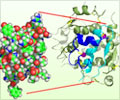In an attempt to treat obesity and diabetes, scientists have identified a new treatment that uses the joint effect of two hormones, important in metabolism, to reduce appetite.

Previous results from animal studies showed that glucagon/GLP-1 combination might be an effective lead to combat obesity and diabetes. The hormones play key roles in regulating blood sugar.
Glucagon works in opposition to insulin, preventing the storage of glucose in fat deposits and the liver, and raising blood sugar levels. GLP-1 stimulates the release of insulin to lower blood sugar and also acts at the brain to reduce appetite, reported Science Daily.
Professor Stephen Bloom, head of division of diabetes, endocrinology and metabolism, Imperial College London, said: "The hormones glucagon and GLP-1 are both used by the body to control blood sugar and metabolism, so there is great interest in utilising them to find new treatments for obesity and type 2 diabetes."
"We found that volunteers treated with a glucagon/GLP-1 combination consumed significantly less food. These data replicate our findings in animals, suggesting that a glucagon/GLP-1 combination may be a promising lead from which to develop a new treatment for obesity and diabetes," said Bloom.
Source-IANS















